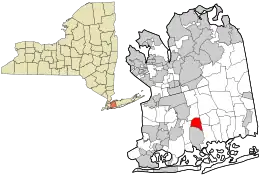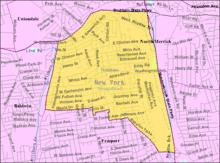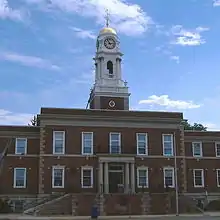Roosevelt, New York
Roosevelt is a hamlet and census-designated place (CDP) in the Town of Hempstead, which is in Nassau County, New York, United States on Long Island. The population was 16,258 at the 2010 census.[1]
Roosevelt, New York | |
|---|---|
Hamlet and census-designated place | |
 Location in Nassau County and the state of New York. | |
| Coordinates: 40°40′45″N 73°35′8″W | |
| Country | United States |
| State | New York |
| County | Nassau |
| Named for | Theodore Roosevelt |
| Area | |
| • Total | 1.8 sq mi (4.6 km2) |
| • Land | 1.8 sq mi (4.6 km2) |
| • Water | 0.0 sq mi (0.0 km2) |
| Elevation | 39 ft (12 m) |
| Population (2010) | |
| • Total | 16,258 |
| • Density | 9,000/sq mi (3,500/km2) |
| Time zone | UTC-5 (Eastern (EST)) |
| • Summer (DST) | UTC-4 (EDT) |
| ZIP code | 11575 |
| Area code(s) | 516 |
| FIPS code | 36-63506 |
| GNIS feature ID | 0962860 |
History
The community is named for former President Theodore Roosevelt, but was also known as Greenwich and Rum Point for a time before that. While Roosevelt once had a predominantly-white population, white flight and real estate blockbusting became a major issue during the postwar housing boom in the 1950s and 1960s, when the community saw an influx of African-American residents.[2]
Notable residents of the community have included both Flava Flav and Chuck D. of Public Enemy, actors Eddie and Charlie Murphy, NBA Hall Of Fame basketball player Dr. J (Julius Erving), NBA Hall Of Fame basketball player Nate (Tiny) Archibald, singers Aaron and Damian Hall and radio host Howard Stern. In addition, Melvyn M. Sobel, James V. Petrungaro and David D. Weinberg, the original three members of The Ravens, a rock group well known on Long Island, performed from 1965–1969.
According to the 2010 census, the population of Roosevelt is 16,272. The median household income is listed as $68,625.
Geography

According to the United States Census Bureau, the CDP has a total area of 1.8 square miles (4.6 km2). 1.8 square miles (4.6 km2) of it is land and 0.56% is water.
Demographics
As of the census[4] of 2000, there were 15,854 people, 4,061 households, and 3,362 families residing in the CDP. The population density was 3,438.9/km2 (8,916.8/mi2). There were 4,234 housing units at an average density of 918.4/km2 (2,381.3/mi2). The racial makeup of the CDP was 3.97% White, 79.02% African American, 0.46% Native American, 0.49% Asian, 0.05% Pacific Islander, 8.33% from other races, and 3.69% from two or more races. Hispanic or Latino of any race were 16.22% of the population.
There were 4,061 households, out of which 38.3% had children under the age of 18 living with them, 44.2% were married couples living together, 30.3% had a female householder with no husband present, and 17.2% were non-families. 12.0% of all households were made up of individuals, and 4.1% had someone living alone who was 65 years of age or older. The average household size was 3.88 and the average family size was 3.98.
In the CDP, the population was spread out, with 30.5% under the age of 18, 9.7% from 18 to 24, 30.8% from 25 to 44, 20.9% from 45 to 64, and 8.1% who were 65 years of age or older. The median age was 32 years. For every 100 females, there were 88.8 males. For every 100 females age 18 and over, there were 84.4 males.
The median income for a household in the CDP was $56,715, and the median income for a family was $56,380. Males had a median income of $30,694 versus $29,566 for females. The per capita income for the CDP was $16,950. About 10.8% of families and 15.0% of the population were below the poverty line, including 20.1% of those under age 18 and 14.2% of those age 65 or over.
Education
Roosevelt is served by the Roosevelt Union Free School District. Roosevelt High School is the district's high school.[5]
Notable people
- David Ancrum (born 1958), basketball player, top scorer in the 1994 Israel Basketball Premier League
- Gabriel Casseus, actor and screenwriter ("Takers")
- Chuck D and Public Enemy, hip hop artists
- Sandra Dee, actress
- Julius "Dr. J" Erving, former professional basketball player
- Aaron Hall and Damion Hall, singers, of Guy
- Roy Haynes, jazz drummer
- John Mackey, National Football League Hall of Fame member
- Miff Mole, trombonist
- Charlie Murphy, comedian/actor
- Eddie Murphy, comedian/actor
- Arvell Shaw, jazz bassist
- Howard Stern, radio personality
- Steve White, actor
References
- "Race, Hispanic or Latino, Age, and Housing Occupancy: 2010 Census Redistricting Data (Public Law 94-171) Summary File (QT-PL), Roosevelt CDP, New York". United States Census Bureau. Retrieved October 4, 2011.
- "Roosevelt, NY". sundown.tougaloo.edu. Retrieved 2020-09-01.
- http://roosevelt.longisland.com/
- "U.S. Census website". United States Census Bureau. Retrieved 2008-01-31.
- "Roosevelt Union Free School District / Homepage". Roosevelt UFSD. Retrieved 2020-09-01.
Further reading
- Sheldon Parrish, One Square Mile: The History of Roosevelt, N.Y. From an Autobiographical Perspective, New York: Xlibris Corporation, 2009.
- Sheldon Parrish, Beyond The Wishing Well: The History of Roosevelt, N.Y., Vol. 2, New York: Xlibris Corporation, 2010.
- Sheldon Parrish, Bleeding Gold and Blue, New York: Xlibris Corporation, 2013.
- Rosalyn Baxandall and Elizabeth Ewen, Picture windows: how the suburbs happened, New York, NY: Basic Books, 2000.
- Andrew Wiese, Places of their own: African American suburbanization in the twentieth century, Chicago: University of Chicago Press, 2004.
- Marquita L. James, Blacks in Roosevelt, Long Island New York, circa:1985.
